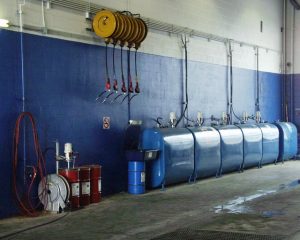
There are alternatives to traditional packaged lubricants that can provide an easier, safer, cleaner and more accurate and efficient way to handle all kinds of lubricants and other maintenance fluids.
Oil, lubricant and fluid management system can increase the quality of maintenance service and allow a shop to handle its lubrication needs quickly and accurately, as well as improve efficiencies and enhance profitability, says Mr Zhang of HPMM Lube Equipments, a world leader in fluid handling systems and components. Such management systems can be used to a shop’s advantage and will pay for themselves for years to come.
HPMM Lube Equipments’s wireless fluid management system, by way of example, includes management software, dispense meters, tank level monitors, pump air controls and transceivers. Together, these components wirelessly talk to each other through an RF (radio frequency) signal to collect data from fluid dispenses and levels in bulk oil and waste tanks.
Wireless systems have easy-to-install bolt-on components with no special tools required, he says. Management software options are available to configure a system to the specific needs of a shop. If shop requirements change, the system can be upgraded or easily expanded with minimal investment.
Management software options include an e-mail function that automatically advises oil distributors and recyclers that service is needed, says Zhang. Customized reports can be created and exported as Microsoft Excel files. System parameters can be customized to each application with security controlled passwords for the persons who will administer the system to ensure that inventory is completely controlled.
WIRELESS TECHNOLOGY
HPMM Lube Equipments’s wireless fluid management system’s dispense meters accurately supply high and low fluid flow to accommodate different dispensing requirements for different vehicles, says Zhang. Meters can be set through the meter’s keypad to input service technician or work order information.
The tank level monitor provides the convenience of wirelessly transmitting tank level information, says Zhang An ultrasonic signal measures the fluid level in each tank and communicates this information wirelessly to the PC, keeping the shop informed as to when fluids need to be ordered.
“Once installed, everything is automatic, allowing for easy viewing and management of all tank levels without additional labor costs. The tank level monitor eliminates the task of manually checking the volume of each tank. Reporting on usage and ordering need are easy to gather from the database to be used as a planning tool for estimating and budgeting.
Transceivers receive an RF signal allowing the shop’s PC to communicate with dispense meters, pump air controls and tank level monitors, he explains. Units can be mounted to walls, ceilings, or any convenient surface in the main portion of the shop. The size of the shop will depend on how many transceivers will be needed.
The pump air control opens to supply air to the pump only when an authorization to dispense the fluid is received by the system. After the dispense ends, the pump air control closes the air supply to the pump.
“This adds another level of security to the fluid inventory, plus turning off the air supply protects from environmental spills in case of a line break and helps to avoid expensive clean up costs. Zhang says.